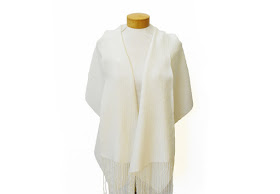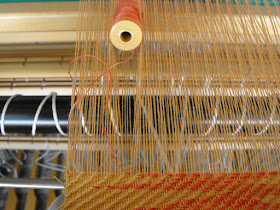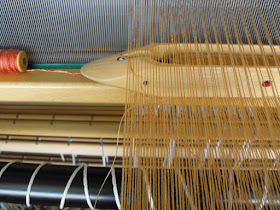When Microsoft changed my Windows 7 to Windows 10 some pictures disappeared into a weird folder and I just found them so here is the post to go with the missing photos. If it seems a little familiar I think that I weave these creamy shawls every year.
The warp is enough for two shawls and it is 2/20 Tencel/Cotton blend in Natural with a white Rayon knop yarn. This time I had some trouble with the warp even though I followed my own instructions. The reed that I usually used pulled the knops on the rayon and even frayed the 2/20.
I had to change to a larger reed that would let the knops through. But that lead to the problem of the 2/20 threads being sleyed three per dent and having reed marks show up on the shawl. The threads almost look braided together.
The solution was to weave about two inches and then move the threads by hand with a needle into the correct spots. It was very slow going but I had a time line for this shawl because it was a custom order.
This shawl also had the additional problem of the right hand floating selvedge shredding. So I had to pin another floating selvedge on but I left the pin head sticking out a little bit and I looped the weft over it twice! Sometimes it seems that I spend more time unweaving then weaving.
The shawl gets cut off and finished to meet the time line for the custom order. It is really pretty with the freshwater pearls and seed beads in the fringe. It was sent to a lady in Australia and she loved it!
For the second shawl I didn’t change the reed, hand manipulating the threads worked and you couldn’t see any reed marks in the finished shawl. The trick was to not weave too much and run the needle along the thread gently moving it into a more open position, almost like strumming a guitar.
This time I managed to loop the weft around the paper clip temple three times! More unweaving.
I did make a rather terrible mistake on the second shawl. I stepped back from the shawl and noticed a weird line going across the second shawl. The weft thread had gotten thinner at the end of cone but I didn’t notice it until I had woven it into the shawl. The mistake was that I left that line of thread in; I thought that it would bloom in the water and you wouldn’t notice it.
Well it didn’t wash out and it was noticeable in the finished shawl. I should have pulled it out but I didn’t so I had to figure out a way to fix it. First the shawl had to sit in the cupboard for a couple of months. But then inspiration struck.
Mum came up with the idea of doing an embroidery stitch on the shawl. The stitch is called Scroll Stitch and it looks like little knots going across the shawl. The thread used is a fine cotton and silver thread that adds a little extra shine to the shawl.
The finished design was four lines of silver stitching that are four different lengths. The back of the Scroll Stitch is a plain vertical stitch but it does add sparkle.
The shawl is quite pretty and the Scroll Stitch is very subtle when the shawl is being worn. For Sale.
Final Garden Shot are large purple Alliums - they are a new addition to the front garden and they make quite a statement!
Pages
▼
Friday, May 19, 2017
Wednesday, May 10, 2017
Clasped Weft with 8 Shaft Undulating Twill
This is another post of a forgotten project from when I was a part of a study group on Inlay last year. While technically Clasped Weft isn’t Inlay you can use it to get a look very similar to Inlay without all the problems.
The scarf warp is 2/8 Tencel in Straw and I choose a simple undulating twill for the pattern. Clasped Weft is usually done with plain weave but I wanted a more interesting design; but it had still had to be simple.
I used two end feed shuttles that had 2/8 Tencel in Straw and a small bobbin with thick and thin hand dyed Silk in various shades of oranges and golds.
The centre panel of the scarf is the orange silk that is clasped to each side of the scarf. I gently pulled the warp threads apart to place the silk bobbin inside of the shed.
I would then pull the bobbin to the right side and then back to the left while unraveling thread to create a loop. Leaving the bobbin on the left side of the warp.
Then with the shuttle from the right side throw the shuttle to the left side, then clasp the silk and throw the shuttle back to the right side. Be careful to miss the floating selvedge on the left side but use the one on the right.
With the clasped silk thread you can manipulate it to where you want each particular pick to lay. Set the pick with a gentle tap of the beater.
That is only half of the pick done, now move silk bobbin back through the shed to the right side creating a second loop. Use the shuttle from the left hand side and capture the silk loop. And pull the clasped weft into position on the left side. Set the pick with a gentle tap of the beater.
Last step is to remove the silk bobbin from the web. Then you can change to the next treadle and start everything again. If that seems like a lot of steps and time, well it was! It took me about an hour to do one inch! Near the end of the scarf I was able to go a bit faster and do two inches per hour. Tedious doesn't even begin to express it!
I didn’t have a plan on where I wanted to have the orange silk, but I did have a couple of rules that I followed. I didn’t go past one inch from the edges and I used the strong pattern changes to help hide to clasped weft loops.
The twill pattern became a texture because each pick was a double thread pick. The texture is still part of the scarf even after washing and steam pressing the scarf.
The scarf is incredibly graphic and it really showcases the variegated orange silk beautifully.
But it is a very time consuming scarf so I don’t see doing another one ever again! For Sale.
Final Garden Shot is the Fothergilla in bloom, it has loads of sweetly scented bottlebrush blooms.
The scarf warp is 2/8 Tencel in Straw and I choose a simple undulating twill for the pattern. Clasped Weft is usually done with plain weave but I wanted a more interesting design; but it had still had to be simple.
I used two end feed shuttles that had 2/8 Tencel in Straw and a small bobbin with thick and thin hand dyed Silk in various shades of oranges and golds.
The centre panel of the scarf is the orange silk that is clasped to each side of the scarf. I gently pulled the warp threads apart to place the silk bobbin inside of the shed.
I would then pull the bobbin to the right side and then back to the left while unraveling thread to create a loop. Leaving the bobbin on the left side of the warp.
Then with the shuttle from the right side throw the shuttle to the left side, then clasp the silk and throw the shuttle back to the right side. Be careful to miss the floating selvedge on the left side but use the one on the right.
With the clasped silk thread you can manipulate it to where you want each particular pick to lay. Set the pick with a gentle tap of the beater.
That is only half of the pick done, now move silk bobbin back through the shed to the right side creating a second loop. Use the shuttle from the left hand side and capture the silk loop. And pull the clasped weft into position on the left side. Set the pick with a gentle tap of the beater.
Last step is to remove the silk bobbin from the web. Then you can change to the next treadle and start everything again. If that seems like a lot of steps and time, well it was! It took me about an hour to do one inch! Near the end of the scarf I was able to go a bit faster and do two inches per hour. Tedious doesn't even begin to express it!
I didn’t have a plan on where I wanted to have the orange silk, but I did have a couple of rules that I followed. I didn’t go past one inch from the edges and I used the strong pattern changes to help hide to clasped weft loops.
The twill pattern became a texture because each pick was a double thread pick. The texture is still part of the scarf even after washing and steam pressing the scarf.
The scarf is incredibly graphic and it really showcases the variegated orange silk beautifully.
But it is a very time consuming scarf so I don’t see doing another one ever again! For Sale.
Final Garden Shot is the Fothergilla in bloom, it has loads of sweetly scented bottlebrush blooms.



























